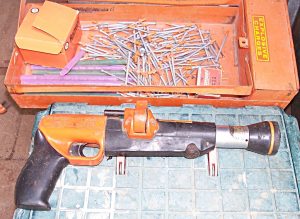Table of Contents
Introduction
A finish nailer is one of the important woodworking tools you’ll need on your various projects either as a professional or hobbyist. Finish nailers are used on wooden and ply boards to carry out finish detailing. It is often mistaken for a brad nailer because a brad nailer is also used where detail is needed, such as mouldings and trims. However, brad nailers are usually smaller than finish nailers.
The nailers are used to nail mouldings and trims into assemblies without leaving too much impact on the appearance. The holes made by finish nailers are barely visible and can be filled with wood fillers to give a smooth exterior.
Types of Finish Nailer
A finish nailer comes in two variants: pneumatic and cordless. Pneumatic nailers use compressed air from a compressor attached via a hose to push the nails out. The Cordless nailer uses pressurised air canister, and a battery powers it. A cordless nailer can also have a combustion chamber which creates air pressure.
Pneumatic finish nailers are lightweight, well balanced and easy to manoeuvre. Cordless nailers tend to be heavier compared to pneumatic nailers, but they are not attached to a hose, which makes them more convenient to use.
A pneumatic nailer costs more upfront since you need to purchase all the required accessories like hose and compressor before you can use it. However, cordless nailers are cheaper out rightly, although you will need to spend money purchasing more air canisters. A disadvantage of the cordless nailer is that unavailability of your type of air canister means you will have to halt work.
How to choose a finish nailer
Safety features
Accidents happen, so safety must always be at the back of your mind when undergoing your various projects. Before you choose a nailer, check out the safety features it has to offer you. Your nailer must have a sturdy build to help prevent nails ricocheting. There is a safety nose that has to be depressed before you can use finish nailers.
Trigger operation
The trigger operation can either be a bump or sequential firing. Bump firing is the quicker way of firing nails, as long as you keep the pressure on the trigger. Sequential firing needs you to release the pressure before you can fire another nail. Some nailers have both options.
Weight
The nailer is something you will have to hold for varying durations so it stands to reason that you will choose the one you can comfortably hold without subjecting your hand and wrist to too much strain.
Cordless finish nailers are bulkier than pneumatic nailers because they have inbuilt batteries. Pneumatic nailers generally are lighter but are attached to a compressor, so they may not be as flexible as the cordless nailers.
Power
Finish nailers have different power outputs; the type of nailer depends on your needs, and how well you can handle the nailers. If the power output is too great for you to handle, you may not get the desired result from the nailers.
The angle of the nailer
You can opt for straight nailers or angled nailers. Straight nailers will give you more power and offers more stability than angled nailers. However, angled nailers let you reach spots that will be otherwise hard to get to with a straight nailer.
Durability
There are different brands of nailers out there, each with varying durability. You can do your research and find the ones that last long, and offer the warranty that suits you.
Cost
As always, the price will always be a factor to consider when you want to get your mailer. You can opt for the premium brands of finish nailers if the cost is not too much for you. However, if you have a tight budget, go for something cheaper and practical. It doesn’t need to come loaded with features.
Tip on using your finish nailer
- Nail blowouts are the most common occurrences when using nailers due to mistakes. To prevent nail blowouts, you must ensure that you align the nailer properly, and the nail tip is directly in the centre of where you intend to nail.
- After placing the nail in the middle of the point you intend to drive it through, align the pin properly and point it in the correct direction
- Choose the right magazine for your project. There are straight and angled heads, which have different uses. Angled heads will help you reach tight spots and corners easily.
- In case of a nail jam, finish nailers have been built with a latch, which you can open easily and remove the jammed nails. When removing jamming nails, always make sure you have removed the battery from the nailer, and disconnected it from the compressor to prevent accidents.
Can you use a finish nailer for framing?
A finish nailer is not suited to framing and other large carpentry works. For framing, you need to get a framing nailer. Framing nailers are heavy-duty nailers and are more powerful finish nailers. Finish nailers don’t have the required power output for framing. Also, they use smaller nails than framing nailers.
Conclusion
Using a finish nailer is the best thing you can do when making finishing touches. It helps you nail woodworks seamlessly without having a big impact on it. The major advantage of finish nailing is that there’s a lesser chance of splitting delicate trims, and also it holds the assembly better than adhesives.
Always wear safety gear when operating the nailer, read the instructions carefully before operation. If you are a novice at handling it, you can ask a professional to guide you.
Other types of nailers may interest you, such as Best Roofing Nailers‘ Best Electric Nail Guns‘

